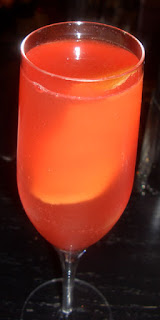
The theme for this month's
Mixology Monday (MxMo XLVIII) is "Pain in the Ass Drinks" as picked by Seattle bartender Mike McSorley who runs the
McSology blog. Mike described his chosen theme as, "document your (least) favorite drink that is the proverbial thorn in your side. It can be virtually anything stylistically- The point here is to have fun and share that little ticket item that throws you off your cleaning game 10 minutes before last call!"
This theme itself was a pain in the ass, for I was stumped as to what to make for it. While I know that Tiki drinks can be a major pain to make between the dozen different ingredients and the sometimes rather festive and ornate garnishes, I wanted to take a different route. Furthermore, the Ramos Gin Fizz with its multi-minute recommended shake did pop into my head, but I had already written about it
here and created a playful
variation of it as well. I also thought of a multi-leveled Pousse-Café, but after the
last one, the effort did not seem worth the reward. Therefore, I asked bartender Sam Treadway for a suggestion when we were at Drink last Monday. The drink he suggest, the Rubicon, most certainly fit the bill.
Rubicon
• 1/2 oz Green Chartreuse
• 1 Rosemary Sprig
Curl sprig in a rocks glass and light Chartreuse on fire.
• 2 oz Gin (Bombay Dry)
• 1/2 oz Maraschino Liqueur (Luxardo)
• 1/2 oz Lemon Juice
Shake with ice and strain into a rocks glass to extinguish the flame. Top with crushed ice, and (optional) garnish with a fresh sprig of rosemary.
The Rubicon was created by
Jamie Boudreau as he was toying with various aspects of molecular mixology. Jamie described the drink's name as, "The rosemary curled in the glass reminded me of Caesar's laurels and therefore I've named this libation after the famous river Caesar crossed in 49 BC after uttering the now famous words: ‘Let us go where the omens of the Gods and the crimes of our enemies summon us! THE DIE IS NOW CAST!’ It is with this action that the Roman Empire began, and western civilization as we know it."

While Rome was not built in a day, this drink was; however, it took a few fold longer to mix than an average drink. The drink began with me shopping for fresh rosemary to make the drink. The extra shopping step was the first of the pain in the ass aspects with the other being the fire step (and a paranoia that my rocks glasses would crack from the heat), the shaking step (standard, but with the added pressure to get it ready to extinguish the Chartreuse at the right time), and the crushed ice step.

Sam had originally described the drink as an Aviation on top of Chartreuse and rosemary, but the end product was pretty distant and more akin to a Last Word. The Rubicon started with an herbal burst of rosemary and green Chartreuse on the nose. The sip had a bitter lemon flavor with rosemary and Maraschino on the swallow. The rosemary made the drink more bitter than even the Last Word, and it worked well to bring out the juniper notes in the gin. The drink made me think of Christmas and Christmas trees (in a good way) as well as the
Rosemary's Baby we had last summer.
In the end, the Rubicon was not that big of a pain in the ass after all, but time was on my side as I was not swamped with drink orders at that moment. And watching the rosemary and Chartreuse burn did make it all worthwhile not to mention the joy of actually drinking it myself.
Cheers to Mike for hosting and picking this month's theme and to Paul Clarke for being the wizard behind the MxMo curtain!





 The theme for this month's
The theme for this month's 

 1 1/2 oz Pierre Ferrand Ambre Cognac
1 1/2 oz Pierre Ferrand Ambre Cognac







 2 oz Medjool Date-infused Gentleman Jack
2 oz Medjool Date-infused Gentleman Jack 1 oz Campari
1 oz Campari







 1 1/2 oz Drambuie
1 1/2 oz Drambuie






 The 2017 collection of 855 drink recipes, bartender tributes, and essays on hospitality from CocktailVirgin's Frederic Yarm. Available at
The 2017 collection of 855 drink recipes, bartender tributes, and essays on hospitality from CocktailVirgin's Frederic Yarm. Available at  The 2012 collection of 505 drink recipes, techniques, and Boston bar recommendations from Frederic Yarm. Available at
The 2012 collection of 505 drink recipes, techniques, and Boston bar recommendations from Frederic Yarm. Available at 



